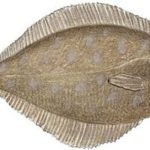 Sole was the fish of choice in the kitchens of ancient Rome, as is suggested by its Latin name: solea Jovi, meaning sandal of Jove, Jove being the supreme deity in the Olympic pantheon. The specific identification of this fish with a variety of footwear was inspired by its perfectly oval form, reminiscent of the sole of a Roman sandal, a symmetry of shape marred only by the unsettling fact that both the creature’s eyes are on the right side of its head. The source of this Latin word for sandal—solea—was solum, meaning both ground and bottom of the foot. Solum, of course, is not only the ultimate source of the marine sole but also of the terrestrial sole, the part of the human body that usually touches the ground. On the other hand, the sole that means alone derives from a different source, as does the homophonic soul referring to our divine essence: that soul derives from a Germanic source that means fleeting, suggesting that, compared with eternity, the time a soul spends in a body is a mere twinkling of an eye. Some species of the marine sole are called lemon sole, but the name has nothing to do with lemons; rather, the lemon is a corruption of the French word for sole, limande, and thus lemon sole is a tautology literally meaning sole sole. The term lemon sole dates back only to the mid nineteenth century, whereas the name sole itself appeared in the mid fourteenth century.
Sole was the fish of choice in the kitchens of ancient Rome, as is suggested by its Latin name: solea Jovi, meaning sandal of Jove, Jove being the supreme deity in the Olympic pantheon. The specific identification of this fish with a variety of footwear was inspired by its perfectly oval form, reminiscent of the sole of a Roman sandal, a symmetry of shape marred only by the unsettling fact that both the creature’s eyes are on the right side of its head. The source of this Latin word for sandal—solea—was solum, meaning both ground and bottom of the foot. Solum, of course, is not only the ultimate source of the marine sole but also of the terrestrial sole, the part of the human body that usually touches the ground. On the other hand, the sole that means alone derives from a different source, as does the homophonic soul referring to our divine essence: that soul derives from a Germanic source that means fleeting, suggesting that, compared with eternity, the time a soul spends in a body is a mere twinkling of an eye. Some species of the marine sole are called lemon sole, but the name has nothing to do with lemons; rather, the lemon is a corruption of the French word for sole, limande, and thus lemon sole is a tautology literally meaning sole sole. The term lemon sole dates back only to the mid nineteenth century, whereas the name sole itself appeared in the mid fourteenth century.
The part under the foot.
A type of flatfish that features a small mouth, small gill openings, and eyes placed quite close together. In the United States, this is typically referred to as flounder. However, the true sole, known as the Dover sole in England, is one of the most highly regarded food fish, and dishes such as fillets of sole and sole meuniere are particularly enjoyed.
